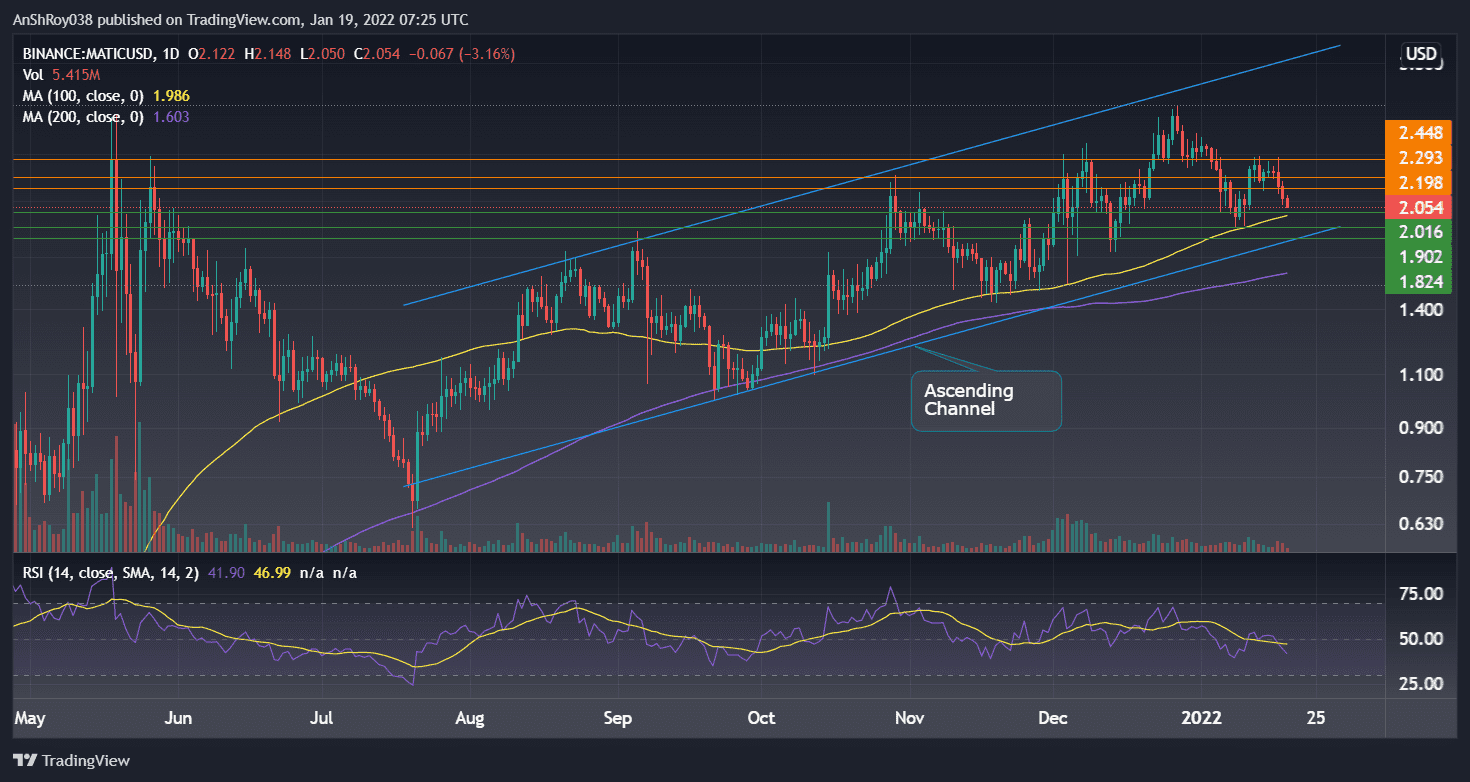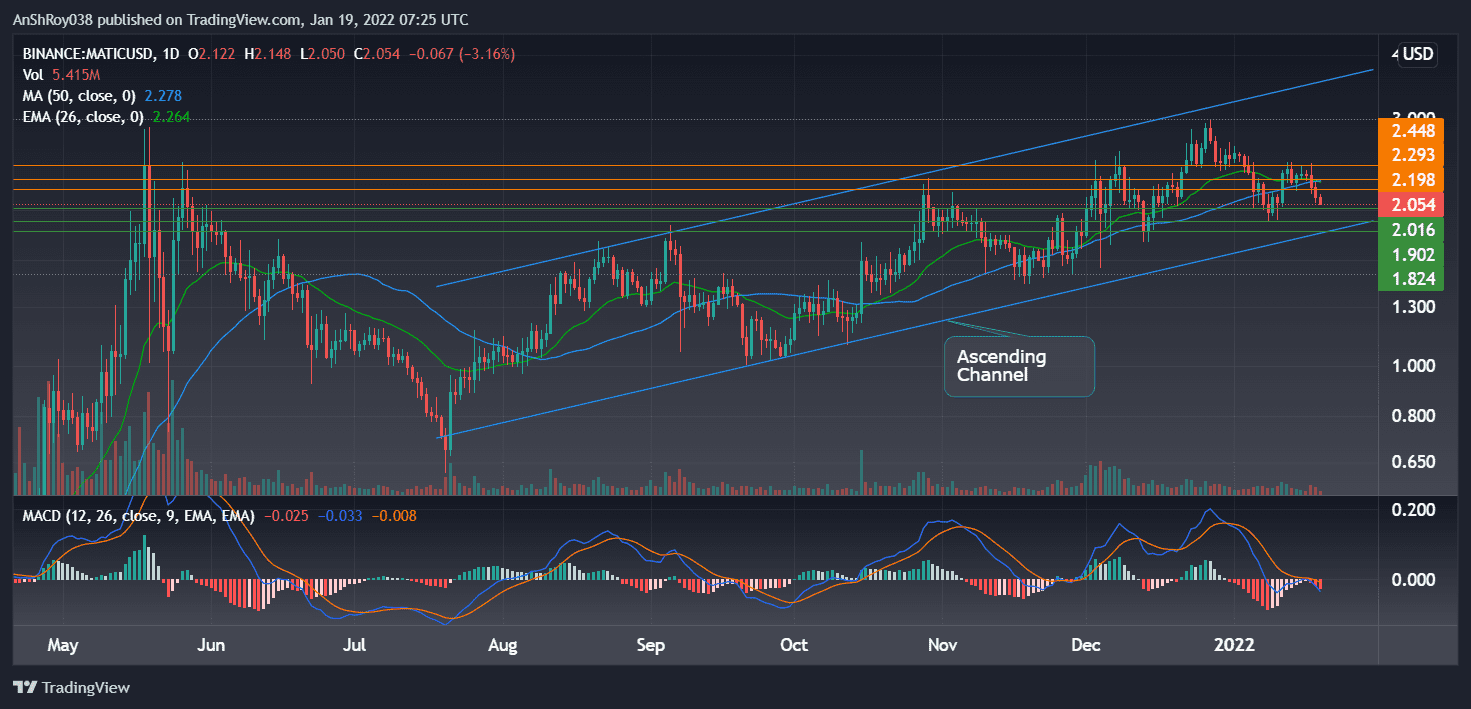
Key Takeaways:
- Polygon (MATIC) introduced Ethereum’s EIP-1559 upgrade to introduce partial network fee burning mechanism.
- However, MATIC prices had no reaction to the news as the token continued its downtrend for the fourth day.
NEW DELHI (CoinChapter.com) — Polygon, an Ethereum Layer-2 (L2) scaling platform, implemented Ethereum’s (ETH) EIP-1559 on its network, as per an announcement shared on Monday.
The much-anticipated update would introduce a partial fee burning mechanism while setting up a base transaction fee. The Ethereum Improvement Protocol (EIP) 1559 upgrade went live in Aug with Ethereum’s London hard fork.
Polygon’s announcement stated the update went live at block height 23,850,000 on its mainnet on Jan 18 at 03:00 UTC, following a successful launch on its Mumbai testnet. The upgrade would bring ‘better fee visibility’ to the network. In addition, the EIP-1559 upgrade would remove the first-price auction method for fee calculation.
Recommended: Binance Chain discontinued BEP2 MATIC; what does it mean for Polygon?
Instead, the upgrade introduces a base fee for Polygon transactions, which the network would burn rather than paying it to Polygon validators. Polygon would compensate network validators with priority fees only. In detail, priority fees are tips that users send to incentivize speeding up transactions.
Polygon explained the burning as a two-step process that starts on the Polygon network and ends on Ethereum. Furthermore, the Polygon team highlighted that the upgrade would not lower the transaction fees on the network. Instead, the latest update would help users determine better estimate costs.
EIP-1559 Upgrade Would Add Deflationary Pressure To MATIC
Polygon’s MATIC token has a fixed supply of 10 billion. As a result, introducing a token burn mechanism would reduce the number of tokens available in the market. In a case analysis studying the impact of implementing EIP-1559 on its network, Polygon concluded that the annualized burn would account for 0.27% of the total MATIC supply.
Deflationary pressure will benefit borth validators and delegators, because their rewards for processing transactions are denominated in MATIC. Because the base fee increases automatically if the block is full, the changes will result in fewer spam transactions and lead to less network congestion
Excerpt from Polygon’s announcement.
Moreover, the deflationary pressure would increase prices, which would benefit Polygon’s validators and delegators. Since they would only receive a priority fee instead of the full transaction fee, increased MATIC prices would help incentivize validators.
Despite being an L2 network, Polygon has recently struggled with gas fees issues. For example, Polygon’s gas fees skyrocketed in the first week of Jan, leading to some validators failing to submit blocks. The Ethereum scaling platform aims to avoid such issues in the future with the EIP-1559 update.
Polygon has burned 19,364.1 MATIC by press time, worth approximately $40,000 at current prices.
Polygon (MATIC) Token Price Charts
MATIC prices failed to capitalize on the news of the latest Polygon update as prices continued to fall on the fourth consecutive day. The downtrend has pared nearly 16% from Polygon’s prices. However, bulls would hope MATIC price rebounds from its immediate support at $2.02, near the Polygon token’s 100-day MA line.
The 100-day MA line has acted as a key dynamic support level for MATIC since Oct 15. Polygon has tested the support level several times in the last three months and has always rebounded to chart a higher high. Moreover, if the MA trendline support fails, MATIC has support coming from the ascending channel’s lower trendline at $1.8.

On the other hand, immediate resistance for MATIC lies at $2.2. If the Polygon token starts an upside rally, MATIC will likely face strong resistance from the token’s 26-EMA and 50-day MA trendline confluence near $2.3. In case bulls manage to conquer the confluence resistance, Polygon could rise to $2.45 before consolidating.
Related: Polygon (MATIC) faces a 50% gain, but bears are up for battle.
The relative strength index is neutral for the Polygon token, clocking 41.9 on the daily charts. However, the RSI trendline is moving down towards the oversold regions, indicating that the bearish price movement may continue for some time.
Meanwhile, trend-based momentum oscillator MACD failed to chart a bullish crossover for MATIC.

Although MATIC’s price momentum seemed likely to move into bullish regions, the ongoing downtrend further strengthened the bears’ grip on the Polygon token’s momentum. To recap, a bullish crossover occurs when the MACD line (difference between 12-day and 26-day EMA) moves above its signal line (9-day EMA of MACD).
Furthermore, bars on the MACD histogram, which plots the difference between the MACD line and its signal line, are expanding.
At the time of writing, MATIC was trading at $2.05, down 3.45% on the day.


